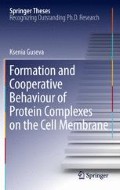Abstract
It is known that many protein complexes are made of smaller identical subunits. The mechanism of assembly of those subunits to form a complete complex is still not well understood. In this work we use a Smoluchowski coagulation equation as a mean-field approximation, and study the efficiency of the process of formation of membrane protein complexes by considering both irreversible aggregation and fragmentation. Our objective is to analyze the possible ways biological organisms adapted to avoid wastage, and achieve a fast formation of the required number of complexes.
Access this chapter
Tax calculation will be finalised at checkout
Purchases are for personal use only
Notes
- 1.
- 2.
- 3.
The primary structure of a protein is its amino acid sequence. The secondary structure the \(\alpha\)-helices and \(\beta\)-sheets. The tertiary represents the chain fold. The quaternary structure is the assembly of those folded polypeptide chains.
- 4.
In this notation C represents the cyclical symmetry of the protein and n the number of subunits that compose this protein. For example: \(C_6\) is a cyclic hexamer.
- 5.
The mechanosensitive channels are described in detail in this chapter.
- 6.
This operator corresponds to the Laplace operator on a curved surface.
- 7.
The maximum time that it takes for the particle to find the cap corresponds to the starting point \(\theta = \pi\) \(W(\pi) = {\frac{2R^2}{D}} \hbox{ln} \left({\frac{R}{r}}\right)\!.\)
References
Ali, M.H., Imperiali, B.: Protein oligomerization: how and why. Bioorg. Med. Chem. 13(17), 5013–5020 (2005)
Blatz, P.J., Tobolsky, A.V.: Note on the kinetics of systems manifesting simultaneous polymerization-depolymerization phenomena. J. Phys. Chem. 49(2), 77–80 (1945)
Blundell, T.L., Srinivasan, N.: Symmetry, stability, and dynamics of multidomain and multicomponent protein systems. Proc. Natl. Acad. Sci. U. S. A. 93(25), 14243–14248 (1996)
Bowie, J.U.: Membrane protein folding: how important are hydrogen bonds? Curr. Opin. Struct. Biol. (2010, in press, corrected proof)
Lo Conte, L., Chothia, C., Janin, J.: The atomic structure of protein-protein recognition sites. J. Mol. Biol. 285(5), 2177–2198 (1999)
Davies, S.C.: Self-similar behaviour in the coagulation equations. J. Eng. Math. 36, 57–88 (1999)
Dayhoff, J.E., Shoemaker, B.A., Bryant, S.H., Panchenko, A.R.: Evolution of protein binding modes in homooligomers. J. Mol. Biol. 395(4), 860–870 (2010)
Hwang, H., Pierce, B., Mintseris, J., Janin, J., Weng, Z.: Protein-protein docking benchmark version 3.0. Proteins 73(3), 705–709 (2008)
Janin, J., Bahadur, R.P., Chakrabarti, P.: Protein-protein interaction and quaternary structure. Q. Rev. Biophys. 41(2), 133–180 (2008)
Krapivsky, P.L., Redner, S., Ben-Naim, E.: A Kinetic View of Statistical Physics. Cambridge University Press, Cambridge (2010)
Levy, E.D., Pereira-Leal, J.B.: Evolution and dynamics of protein interactions and networks. Curr. Opin. Struct. Biol. 18(3), 349–357 (2008)
Levy, E.D., Erba, E.B., Robinson, C.V.: Assembly reflects evolution of protein complexes. Nature 453(7199), 1262–1265 (2008)
Leyvraz, F.: Scaling theory and exactly solved models in the kinetics of irreversible aggregation. Phys. Rep. 383(2–3), 95–212 (2003)
Leyvraz, F., Tschudi, H.R.: Singularities in the kinetics of coagulation processes. J. Phys. A. Math. Gen. 14(12), 3389–3405 (1981)
Lukatsky, D.B., Zeldovich, K.B., Shakhnovich, E.I.: Statistically enhanced self-attraction of random patterns. Phys. Rev. Lett. 97(17), 178101 (2006)
Lushnikov, A.A.: Exact kinetics of the sol-gel transition. Phys. Rev. E 71(4), 046129 (2005)
Lushnikov, A.A.: Critical behavior of the particle mass spectra in a family of gelling systems. Phys. Rev. E 76(1), 011120 (2007)
McLeod, J.B.: On an infinite set of non-linear differential equations. Q. J. Math. 13(1), 119 (1962)
Pereira-Leal, J.B., Levy, E.D., Kamp, C., Teichmann, S.A.: Evolution of protein complexes by duplication of homomeric interactions. Genome Biol. 8(4), R51 (2007)
Ramadurai, S., Holt, V.K.A., van den Bogaart, G., Killian, J.A., Poolman, B.: Lateral diffusion of membrane proteins. J. Am. Chem. Soc. 131(35), 12650–12656 (2009)
Redner, S.: A Guide to First-Passage Processes. Cambridge University Press, Cambridge (2001)
Saffman, P.G., Delbrück, M.: Brownian motion in biological membranes. Proc. Natl. Acad. Sci. U. S. A. 72(8), 3111–3113 (1975)
von Smoluchowski, M.: Versuch einer mathematischen Theorie der Koagulationskinetik kolloider Lösungen. Z. Phys. Chem. 92, 124–168 (1917)
Tilley, S.J., Saibil, H.R.: The mechanism of pore formation by bacterial toxins. Curr. Opin. Struct. Biol. 16(2), 230–236 (2006)
Villar, G., Wilber, A.W., Williamson, A.J., Thiara, P., Doye, J.P.K., Louis, A.A., Jochum, M.N., Louis, A.C.F., Levy, E.D.: Self-assembly and evolution of homomeric protein complexes. Phys. Rev. Lett. 101(11), 118106 (2009)
Vinothkumar, K.R., Henderson, R.: Structures of membrane proteins. Q. Rev. Biophys. 43(1), 65–158 (2010)
Wattis, J.A.D.: An introduction to mathematical models of coagulation-fragmentation processes: a discrete deterministic mean-field approach. Phys. D Nonlinear Phenom. 222(1–2), 1–20 (2006)
Whitesides, G.M., Boncheva, M.: Beyond molecules: self-assembly of mesoscopic and macroscopic components. Proc. Natl. Acad. Sci. U. S. A. 99(8), 4769–4774 (2002)
Author information
Authors and Affiliations
Corresponding author
Rights and permissions
Copyright information
© 2012 Springer-Verlag Berlin Heidelberg
About this chapter
Cite this chapter
Guseva, K. (2012). The Role of Fragmentation on the Formation of Homomeric Protein Complexes. In: Formation and Cooperative Behaviour of Protein Complexes on the Cell Membrane. Springer Theses. Springer, Berlin, Heidelberg. https://doi.org/10.1007/978-3-642-23988-5_2
Download citation
DOI: https://doi.org/10.1007/978-3-642-23988-5_2
Published:
Publisher Name: Springer, Berlin, Heidelberg
Print ISBN: 978-3-642-23987-8
Online ISBN: 978-3-642-23988-5
eBook Packages: Physics and AstronomyPhysics and Astronomy (R0)

